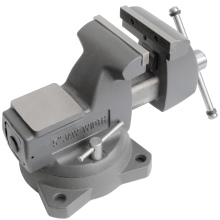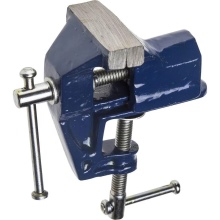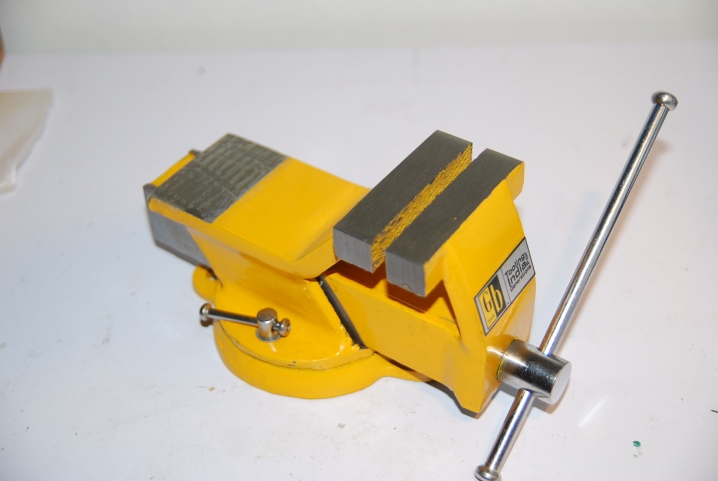All About Desktop Vise

A vice can be found in almost every home workshop. They are simply necessary for some work, and a good master will never refuse to have such a device. With its help, any corner of the house can be turned into a mini-workshop.

Peculiarities
A table vise is a special device, the main task of which is to secure the workpiece as tightly as possible. This ensures the safety of the worker and frees up his hands for other work. The device of a small vice is not striking in its complexity.

Most often they consist of such elements.
- Base - this is the body of the mechanism. Its purpose is to be installed on any flat surface of a table, machine or workbench. Mounting can be done with a bolt, suction cup or magnet.
- Sponges. Usually there are two of them, one is motionless, the second moves. The first is a part of the body, and the second secures the workpiece. Fixation occurs by moving along the guides of the movable vise element to the fixed one. The jaws are completed with replaceable pads, which are called "cheeks". They have different surfaces designed for different tasks. In order not to damage the workpiece, jaws with a smooth outer side are used; for a more reliable fixation, corrugated ones are used.
- Locking bolt with handle for turning. This mechanism is responsible for the movement of the jaw, it goes through the entire body of the vice. The handle makes it easier to turn the screw - in this case, there is no need to use wrenches or other tools.



This is a description of a typical vise, in some cases their design may change. On some models, instead of the clamping bolt, another clamping method, such as hydraulic, may be used.
Also, a jaw lock button can be used in a table vise, it helps to speed up the process of fastening or unclamping.

A vice is made of metal, most often it is steel and cast iron. There may be options from aluminum and other alloys. To work with wood blanks, those made of the same material can be used. Pine is most often used - it is durable and at the same time soft.

Feature small vice their small size and weight can be considered. They can be moved at any time to another place on the table, workbench. It is allowed to fix a vice even on a stool, and it will immediately turn into a workplace. If necessary, it is possible to take the locking mechanism with you along with a set of tools for performing work elsewhere.

Varieties
There are several basic types of vise, and they all have a specific purpose:
- locksmiths;
- machine tools;
- for carpentry work.



Locksmiths
This vise has 3 subspecies. The maximum spreading width of the jaws on a bench vice reaches 250 mm. Their first type is stool. This is a rather outdated type and rarely used. Its distinctive feature is the method of jaw movement. The one that moves away does not move straight, but in an arc with a decent radius. This design has significant disadvantages - the workpiece is not held by the entire surface of the cheeks, and they can only be attached to the edge of the table.
Such a vice has a simple design and allows you to fix long workpieces.

Parallel is the second kind. They are very comfortable, they do not have the disadvantages of a chair vice. The workpiece is securely attached with the entire surface of the cheeks, which can be rotatable and non-rotatable. They differ from others in that the design of the latter does not have a swivel base, and they are attached directly to the table. They got their name because one sponge moves in parallel with respect to the other. These rotary-type vices allow you to change the position of the device in 2 planes (horizontal and vertical) 360 degrees. They are not suitable for heavy work.
They can be mounted using a clamping screw or through holes in the base.

The third type is a hand vise. Small mechanism. As the name implies, it is used for holding in the hands. This is necessary when a small part or workpiece has to be turned over frequently during machining. They are hinged, spring-loaded and with a conical mount, as well as on a suction cup. The advantage of this type are small in size, allowing you to perform various types of work without much trouble and effort. Minuses - small run-up of the jaws and their insufficient width.

The general disadvantages of this type include backlash presence, need check the alignment of the jaws and pay attention to the wear of the lock washers... But there is also pros:
- made of durable metals;
- in the design of many models there is a small platform (anvil) that can withstand strong mechanical stress;
- lightness and small dimensions;
- the sponges have been hardened, as a result of which they are very durable and wear-resistant.

Machine tools
This is a more professional tool used mainly in production. It differs from locksmiths in increased accuracy, moreover, there is practically no backlash on them, and if there is, it is invisible. There are also machine vices for use in household work, they differ from their production counterparts in lower weight and dimensions. These instruments are of three types: stationary, sinus and multi-axis. The advantages of machine tools are increased body strength, no gap, anti-corrosion coating and the ability to fix large parts. Minuses are insignificant - there are distortions of the workpieces, traces of sponges may remain on the parts.

Carpentry
They are used when the parts are made of soft materials such as wood or plastic. The fastening to the surface is most often screw. They are made of wood or can have a combined layout (cast iron and wood). Brushes on a wooden vise are made of rubber, wood or non-ferrous alloys. This is done in order not to damage the part. Some types of joinery vices are equipped with quick-clamping screws for convenience.
Flaw: the inability to work with workpieces of increased strength. Advantages: the ability to work with parts from soft raw materials, large workpieces by fixing the jaws on the same level with the table surface.

How to choose?
When choosing a fixing device, very it is important to pay attention to the fact that working on it subsequently was comfortable and convenient. Only if these conditions are met can a part or workpiece be processed with high quality.

Typically, such requirements are imposed on a vice.
- The length of the run of the jaws must correspond to the parameters of those parts that will be processed in the future. If the vise travel is 200 mm, then it will be difficult to process small elements in them. Conversely, small vices are not suitable for large workpieces.
- The device must have reliable reserve of strength and reliability. In the course of various works, various mechanical loads, including shock ones, act on the vice. The fixing device must be able to withstand them.
- Reliable fixation... The device must be able to securely fix the part, the quality of processing in the future and the safety of the worker depend on this.
- Mounts to the table... The vice should not only fix the part well, but also be securely attached to the surface of the workbench or other objects.This will make it possible to eliminate unnecessary vibrations during operation.
- Possibility of turning. Vices that do not have this capability are gradually becoming obsolete. And now it is desirable to have rotary ones on the farm, they provide more opportunities for processing.
The width of the run of the jaws is of great importance.
For garage a stroke of 150 mm is optimal. If the vice is for housework, then the ideal value of this value is up to 75 mm. If you fulfill all the conditions and choose the right device for fixing, then this will greatly facilitate and speed up the work.

In the next video you can watch an overview of the Zubr 32480 desktop vice.













The comment was sent successfully.